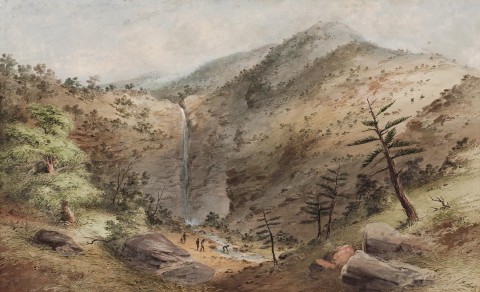MOUNT REMARKABLE, STONY CREEK, c.1865
S.T. GILL
watercolour on paper
41.0 x 67.0 cm
signed with initials lower left: S.T G
Private collection, Melbourne
Thence by descent
Private collection, Sydney
On loan to the Queensland Art Gallery, Brisbane, 1987 (label attached verso, owner: Mr W. Rice)
Stony Creek, Mount Remarkable Survey, from the fall, watercolour on paper, 26.3 x 39.2 cm, in the collection of Art Gallery of South Australia, Adelaide, illus. in Appleyard, R., Fargher, B, and Radford, R., S.T. Gill: The South Australian Years 1839-1852, Art Gallery of South Australia, Adelaide, 1986, p. 21
In the winter of 1846, Samuel Thomas Gill and his friend John Ainsworth Horrocks left Adelaide, Horrocks in search of pastoral land north-west of Mount Arden and Gill ‘for the purpose of filling his note book’.1 The expedition included a camel dubbed ‘Harry’, the first used on such a venture, but unfortunately tied up with its tragic ending through the death of Horrocks by misadventure. Gill’s diary, published in the South Australian Gazette on 10 October 1846, and his numerous sketches taken on the spot provide a fascinating record of what he saw and what transpired. Back in Adelaide, he applied himself to working these sketches into finished watercolours. By January, they were ready for exhibition, the South Australian Register reporting on being favoured with a view of the works:
… depicting the most remarkable scenes met with by the expedition under the conduct of the late Mr Horrocks. The series comprises no less than thirty-three-views, the execution of which, as faithful transcripts of nature and in some instances of a territory untrodden by white men, reflects much credit on the talented artist.2
Some represented the furthest point reached by the party. Others related to Horrocks accident, the ‘inhospitable and desolate appearance’ of the country, and again others to contact, friendly and otherwise, with the Aboriginal people. In its conclusion, the South Australian Register announced that; ‘This interesting series of pictures is to be raffled for in the course of a few days’.3 Today, the major holdings of these watercolours of the Horrocks expedition are in the Art Gallery of South Australia, Adelaide, and the National Library of Australia, Canberra. A number of sepia wash images were also sold by Deutscher and Hackett, Melbourne on 28 November 2012, lot 37. A circular version of our watercolour on offer is in the National Library of Australia, Canberra, titled Fall Near Mt. Remarkable, Flinders Ranges, S. A., c.1846. The nature of its composition gives a more concentrated view on the falls and group of Aboriginal figures at its foot. There are several other related watercolour subjects of Mount Remarkable, the waterfall and Stony Creek, all in the collection of the Art Gallery of South Australia, as detailed in the above. The Mount Remarkable area appealed to Gill, his original studies being made during early August 1846 when Horrocks’ party camped at White’s Station on the Rocky River, north of Wirrabara.4
The presence of Aboriginal figures in Gill’s landscapes and their later frequent appearance in his pictures indicates a growing interest beyond everyday curiosity. While Interview with Blacks before Attack, Horrocks Expedition, South Australia, c.1865 – 70 (Art Gallery of South Australia) recorded a less friendly encounter, our Mount Remarkable, Stony Creek, c.1865 shows a family group, completely at home within their rather picturesquely presented environment. As a maker of pictures, Gill, like his contemporaries, often made further versions of those which proved most popular. The style and larger size of Mount Remarkable, Stony Creek suggests that it might have been painted years later in Melbourne from one of his sketches of 1846.
1. South Australian Register, Adelaide, 4 July 1864, p. 2, quoted in Grishin, S., S. T. Gill & His Audiences, National Library of Australia in association with the State Library of Victoria, Canberra and Melbourne, 2015, p. 48
2. ‘The Arts in South Australia’, South Australian, Adelaide, 5 January 1847, p. 6
3. ibid.
4. Appleyard, R., Fargher, B., and Radford, R., S. T. Gill: The South Australian Years 1839-1852, Art Gallery of South Australia, Adelaide, 1986, p. 89. Mount Remarkable is in the Southern Flinders Ranges, the waterfall on Stony Creek flowing into the Baroota Dam.
DAVID THOMAS
